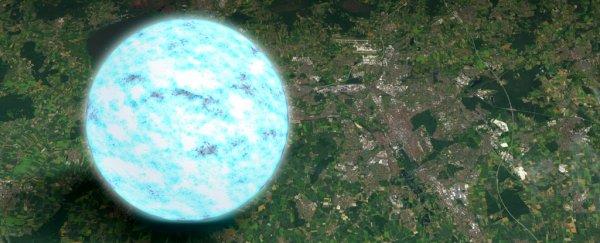How big is a neutron star? These extreme, ultra-dense collapsed stars are fairly small, as far as stellar objects are concerned. Even though they pack the mass of a full-sized star, their size is often compared to the width of a medium-to-large-sized city.
For years, astronomers have pegged neutron stars at somewhere between 19 to 27 kilometers (12 to 17 miles) across. This is quite actually quite precise, given the distances and characteristics of neutrons stars. But astronomers have been working to narrow that down to an even more precise measurement.
An international team of researchers has now done just that. Using data from several different telescopes and observatories, members of the Max Planck Institute for Gravitational Physics, the Albert Einstein Institute (AEI) have narrowed the size estimates for neutron stars by a factor of two.
"We find that the typical neutron star, which is about 1.4 times as heavy as our Sun, has a radius of about 11 kilometers," said Badri Krishnan, who led the research team at the AEI Hannover.
"Our results limit the radius to likely be somewhere between 10.4 and 11.9 kilometers."
The object of this team's study is rather famous: the binary neutron star merger GW170817 which created the gravitational waves detected in 2017 by the LIGO (Laser-Interferometer Gravitational Wave Observatory) and Virgo consortium.
This object has been studied numerous times by multiple telescopes, including the Fermi satellite, the Hubble Space Telescope and other telescopes and observatories around the world. All those observations gave the Max Planck team a boatload of data to work with.
"Binary neutron star mergers are a gold mine of information!" said Collin Capano, researcher at the AEI Hannover and lead author of a paper published in Nature Astronomy.
"Neutron stars contain the densest matter in the observable universe. … By measuring these objects' properties, we learn about the fundamental physics that governs matter at the sub-atomic level."
Neutron stars are formed when a massive star runs out of fuel and collapses. The very central region of the star – the core – collapses, crushing together every proton and electron into a neutron.
If the core of the collapsing star is between about one and three solar masses, these newly-created neutrons can stop the collapse, leaving behind a neutron star.
Stars with even higher masses will continue to collapse into stellar-mass black holes.
But the collapse into a neutron star creates the densest object known – again, an object with the mass of a sun crushed down to the size of a city. And you've probably heard this other comparison before, but it's worth a repeat because of how dramatic it is: One sugar cube of neutron star material would weigh about 1 trillion kilograms (or 1 billion tons) on Earth – about as much as Mount Everest.
But since the size of other stars can vary widely, couldn't the size of neutron stars also vary?
First, to clarify, the radius quoted in this study is for a neutron star that has a mass 1.4 times that of our Sun.
"This is a fiducial mass that's typically used in the literature because nearly all neutron stars that have been observed in a binary have a mass close to this value," Capano told Universe Today in an email.
"The reason we can use GW170817 to estimate the radius of 1.4 solar-mass neutron star is that we expect nearly all neutron stars to be made of the same stuff."
For other "regular" stars, the relationship between their mass and radius depends on a number of variables, such as the element that the star is fusing in its core, Capano explained.
"Neutron stars, on the other hand, are so compact and dense, that there are not really separate atoms in them – the entire star is basically a giant single atomic nucleus, consisting almost entirely of neutrons packed tightly together," he said.
"For that reason, you cannot think of neutron stars as being comprised of possibly different elements. Indeed, 'element' doesn't really have any meaning at these densities, since what defines an element is the number of protons it has in its constituent atoms."
Capano said that since all neutrons are made of the same things (quarks, held together by gluons), astronomers expect there to be a universal mapping between the mass and radius that applies to all neutron stars.
"So, when we quote the possible size of 1.4 solar mass neutron star, what we're actually doing is constraining the possible physical laws that describe the sub-atomic world," he said.
As the team describes in their paper, their results and processes can also be applied to the study of other astronomical objects, like pulsars, magnetars, and even the way gravitational waves are emitted to provide details of what is creating these waves.
"These results are exciting, not just because we have been able to vastly improve neutron star radii measurements, but because it gives us a window into the ultimate fate of neutron stars in merging binaries," said Stephanie Brown, co-author of the publication and a PhD student at the AEI Hannover.
This article was originally published by Universe Today. Read the original article.
